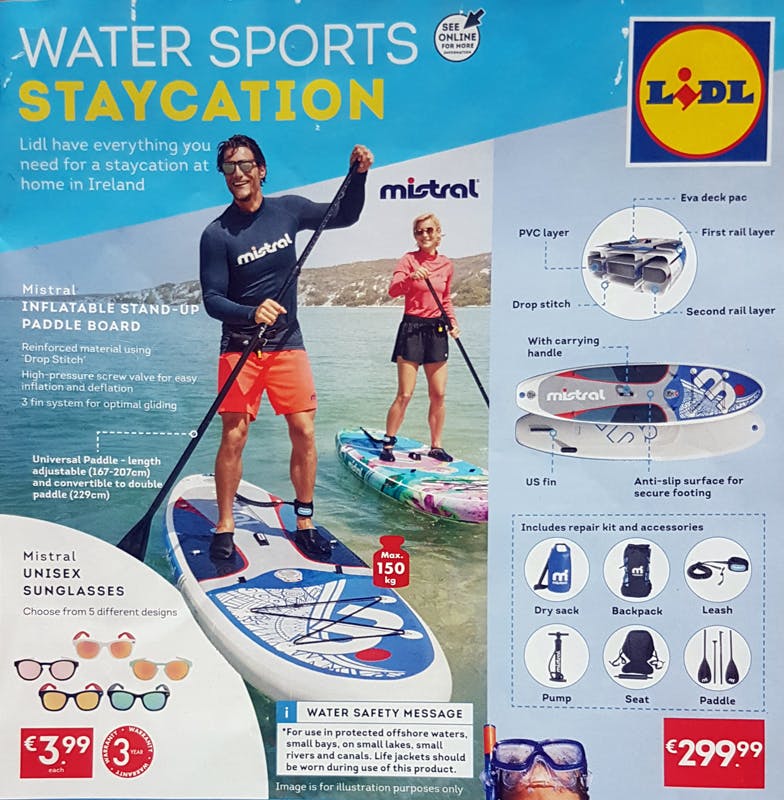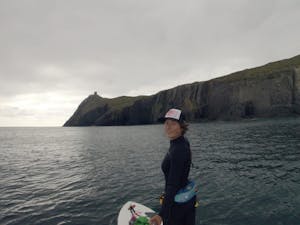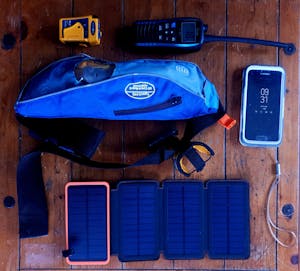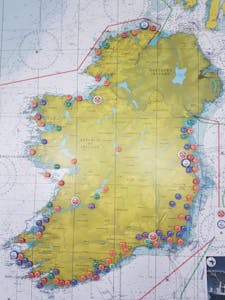SELF RESCUE TECHNIQUES FOR STAND UP PADDLE BOARD TOURING

You know summer is right around the corner when Lidl brings out an inflatable stand up paddle board for only €300. While being great exposure for the sport, it also means that anyone can buy a cheap board without having to speak to anyone who actually knows what they are doing. It sounds like a real recipe for potential disaster, especially since there won’t be that many life guards on Irish beaches this summer.
So, while I wholeheartedly recommend that people start stand up paddle boarding. I also wholeheartedly recommend that people take a lesson first with a certified instructor. SUPS are not toys. There are real potential risks that need to be considered every time you go out to enjoy the water.
Here are some of the things to look out for and some of the things you might do if you do find yourself getting into trouble.
Last summer, when I was paddling up the Wild Atlantic Way, I encountered a few challenging moments. One in particular springs to mind when I think about self rescues.
I was paddling from Castletownbere to Dursey Sound. There was a decent strength breeze blowing from the north but it wasn’t much of a problem because I was paddling below some pretty big cliffs and had good shelter. I was reaching a point on the map where I would have to round a headland, paddle north for roughly 2 kilometres and then continue my journey in the shelter under the cliffs heading west.

I started to round the corner and felt the wind begin to pick up. It was fine, I was expecting this. I got down to my knees and paddled the rest of the way around the point. I was looking due north when the true strength of the wind hit me. I put my head down and started paddling hard. There was wind fetch a few feet high, spray was flying, my eyes were watering and nose running, but I couldn’t stop paddling for even a second or I would loose precious ground. I kept telling myself, it’s only a few kilometers, you can power through it. I took this up like a mantra with each stroke of the paddle I made.
I quickly realised it was impossible. There was no way I could paddle that far in these conditions. What was I to do?
If I turned back, I’d have to paddle along the cliffs for at least 10 kilometers before I found a place to exit the water. My only real choice was forward. But I wasn’t physically capable of doing that either.
I kept paddling, making almost no headway against the wind, but I was still creeping forward inch by inch. I had paddled maybe 100 feet around the headland when I looked to my right, and low and behold, I saw moored boats! Boats meant there would be a jetty or slipway and that meant an exit point. I turned to the right and struggled over to the relative calm created by the land spit in front of me.
When I was out of immediate danger, I pulled my mobile phone out and rang Ed. Thankfully I had phone signal! Ed picked up. He was waiting for me at our pre-arranged meeting point. I told him there was no chance I’d make it that far. I sent him the location of the slip way I was headed for and proceeded to paddle the rest of the way back to shore. I was safe.

The fateful headland in the distance when I was still on the sheltered side
There are a few things we can learn from this story.
Know the area you are paddling in
I had scoped out this stretch of coastline to a certain extent. I knew there were a few exit points despite the high cliffs and I had discussed them with Ed. I did not know about the slipway I did use though. It was essentially pure luck that it was there where and when I needed it.
I generally use the satellite map and the street view features on Google Maps to suss out a stretch of coastline before I paddle it. That way I can see, more or less, what the topography of the land looks likes, even if I am planning the paddle remotely.
ASK A LOCAL. This is one of my favorites. It’s how I learned about the pier I landed on after rounding Mizen Head.
Know the weather conditions before you launch
In this instance, I knew the wind direction and strength. I knew there was a very small bit of swell. But, I misinterpreted what those figures meant in real life. This is something that comes with experience. The more I paddle, the better I become at gauging what are reasonable conditions to paddle in.
For instance, I know I can paddle against a five knot headwind, but I also know I can’t do it for a sustained period of time. I know that anything above a force 4 wind in an exposed area is too much for me to handle, and I’ll either wait for the wind to drop or find another location to paddle. When first starting out, here is a handy rule of thumb. If there are white caps on the wind fetch, find shelter, or arrange your paddle to go downwind.
Talk to people, talk to other experienced water uses. Tell them what you are planning and ask their advice. One day, you’ll be giving advice to a novice paddler and the cycle continues.
Always have someone on land who knows what your plan is
I was delighted that Ed was around in that moment, so that he could come pick me up, we could get a hot meal and sleep in the cozy van that night. Though, if he hadn’t been, things wouldn’t have been much different. I still would have called him and told him the change of plans and I still would have sent him my new location. The only difference is, I would have asked one of the houses near to the slip way if there was someplace I could pitch my tent and set up camp. My evening would have been a little bit less comfortable but someone else would still know what was happening.
A person on land who knows what is happening can also raise the alarm bell if something goes wrong and you don’t check in as scheduled.
Always bring a phone, radio, or other reliable form of communication out with you into the water

I couldn’t have called Ed if I didn’t have my phone with me. I would have had to walk the rest of the way to our prearranged meeting place on land, at least another 10km. I was lucky to have phone signal though. In many areas, especially below cliffs, there is none. That is why I also bring a VHF radio with me. If all else is lost, I can at least hail a near by boat or reach out to the coastguard.
I have a solar charger with me as well so that I can keep my phone charged in the event I need it. Be sure to have your phone in a waterproof pouch. I wouldn’t trust my phone’s self prescribed waterproofness in such situations, and certainly not in salt water. Ghostek is a good brand we found that make waterproof cases at a reasonable price.
Satellite phones are also good options. There are many different choices out there but any good outdoor shop worth it’s salt would be able to advise you on the best options.
I also have a Personal Locator Beacon, or PLB, attached to my buoyancy aid. This is only for extreme instances where self rescue is not an option and my phone and radio are dead or gone. If all is lost, I can press the emergency button and the coastguard will be notified instantly. Each PLB is registered to a specific individual, so the coastguard will immediately know who is in trouble and where they are.
You may have heard me say this before, but I’ll say it again. Stand up paddle boarding, or any other human powered watercraft really, differs from cycling and running in one very key way. Once you launch on a SUP, you cannot stop until you are back on land. When running or cycling, if you get tired or bored you can always stop, rest or call a cab. That is not an option out on the water. You have to get yourself back to land on your own, one way or another.
I actually really like this about SUP. There is a real sense of self reliance and accountability. I must take complete ownership over my experience. There is no if and or buts about it.
 The coastguard is an amazing resource that does truly fantastic work. I know many people in the coastguard and they are more than happy to drop everything to go help a person in trouble. Most people in the coastguard are actually volunteers. They are there to be called upon if needed. The goal, however, as pleasure water users, is to NOT EVER NEED THEM.
The coastguard is an amazing resource that does truly fantastic work. I know many people in the coastguard and they are more than happy to drop everything to go help a person in trouble. Most people in the coastguard are actually volunteers. They are there to be called upon if needed. The goal, however, as pleasure water users, is to NOT EVER NEED THEM.
I say again, I can’t recommend stand up paddle boarding enough! It is such an exciting, fulfilling way to explore the coastline, get fit, and enjoy the great outdoors. However, it is not to be taken lightly. The ocean demands respect and respecter her I do.
If you are thinking about getting into SUP, find a school, get some expert knowledge, and jump in with the best chance of success you can. We, here at Wild SUP Tours, would be delighted to introduce you to the sport. If Dingle is no good for you, here is a link to the “find a school” page on the Academy of Surfing website, one of the largest governing bodies for SUP schools around the world.
